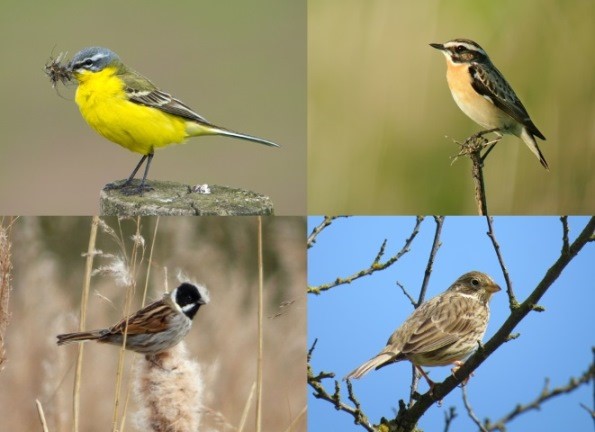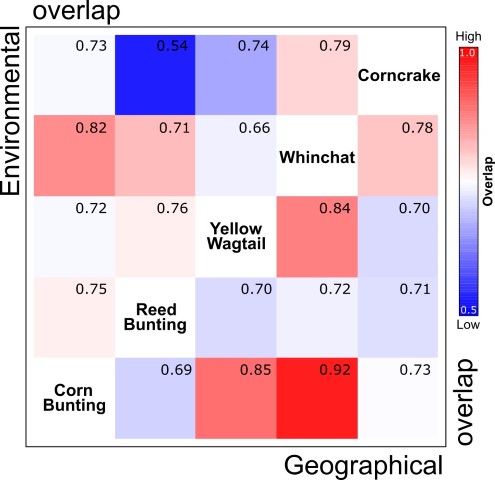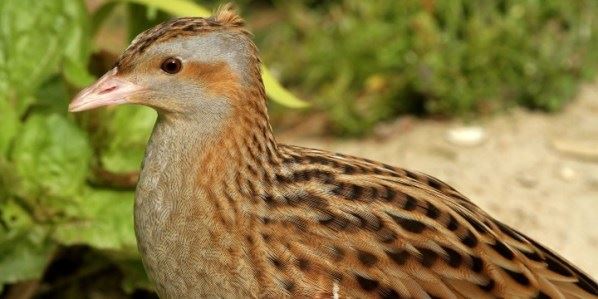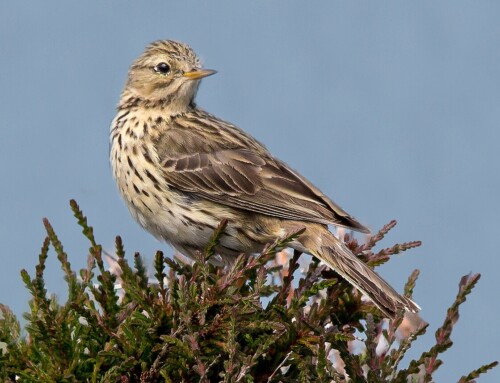Can we conserve the entire grassland avifauna by protecting the Corncrake only?
LINKED PAPER
Evaluating interspecific niche overlaps in environmental and geographic spaces to assess the value of umbrella species. Fourcade, Y., Besnard, A.G. & Secondi, J. 2017. Journal of Avian Biology. DOI: 10.1111/jav.01153. VIEW
Grassland habitats are among the most endangered ecosystems worldwide, and host many threatened bird species. A charismatic dweller of European grasslands is the Corncrake Crex crex, well known for its loud nocturnal call, but very challenging to see due to its inconspicuous daytime behaviour. Agricultural intensification, especially earlier mowing dates, caused marked declines in Corncrake populations over the last decades (Green et al. 1997). These declines motivated the implementation of conservation measures in many European countries to enhance Corncrake survival and reproductive productivity.
The corncrake as an umbrella species
The conservation of the Corncrake is frequently advocated as a means of conserving local grassland ecosystems. Hence, conservation measures aimed at protecting the Corncrake are also expected to protect the other grassland bird species, especially those that are also at risk from human practices. This desirable side-effect characterises a so-called umbrella species, that is, a species whose conservation benefits all species sharing the same habitat (Caro & Doherty 2003).<!–?p ></p> <p>One of the last populations of Corncrake in France breeds in floodplain meadows along the western banks of the Loire river and some of its tributaries. Here, agri-environmental schemes were implemented to maintain the Corncrake population, but they were also supposed to benefit a larger number of species. Among them are four ground nesting passerines that occur in the same grasslands and whose breeding seasons overlap (Figure 1). It is assumed that the corncrake and these passerines really co-occur in the same areas and share the same environmental requirements. However, this crucial information was never formally quantified. Therefore, the question remains as to whether the Corncrake has the potential to act as an effective umbrella species in this area.
Figure 1 The four passerine species that are expected to benefit from the conservation of the corncrake in western France. From left to right, top: Yellow Wagtail Motacilla flava (© Rob Zweers – CC BY 2.0), Whinchat Saxicola rubetra (© Frank Vassen – CC BY 2.0); bottom: Reed Bunting Emberiza schoeniclus (© gailhampshire – CC BY 2.0), Corn Bunting Emberiza calandra (© Alastair Rae – CC BY-SA 2.0)
Measuring geographical overlap and environmental overlaps
In this study, we aimed to measure how much the Corncrake and the four dominant passerine species overlap in the environmental and geographical spaces, i.e. whether they have a similar ecological niche and spatial distribution. This was a way to assess, disregarding the actual effectiveness of conservation measures, whether actions targeted at the Corncrake could also potentially confer protection to passerines.
We surveyed almost all the grasslands of the area during the birds’ breeding season to record the location of as many individuals as possible of each species. We also mapped several environmental variables, describing climate, landscape structure, vegetation productivity and flooding risk, that were likely important for determining the local habitat of these species. Using these data, we quantified to what extent the different species occupied the same range of environmental conditions. Then, we built a statistical model to predict their spatial distribution, and used this model to quantify the degree of geographical overlap between species.
Towards a multi-species approach?
Models predict that the Corncrake has a more restricted distribution than passerines (Figure 2). Worse, we knew that its local distribution has gradually declined over the years, so that the areas actually occupied by the Corncrake represent only a fraction of its potential distribution. Therefore, although current measures certainly have merits as they ensured the maintenance of the grassland habitat against conversion to intensively-managed agriculture, some important meadows would be left unprotected if all conservation actions were targeted on the Corncrake’s current habitat only.

In general, our approach revealed substantial differences in the spatial distribution and ecological requirements of the five species studied (Figure 3). As such, no single species seems able to cover the entire range of ecological conditions used by the other focal species and to overlap 100% of their local distribution. For example, the Yellow Wagtail Motacilla flava has the largest distribution and a broad overlap with the other species, except with the Corncrake! An alternative might be to jointly consider the Corncrake and the Whinchat Saxicola rubetra as umbrella species: they are both threatened at the national level, and when combined they largely overlap with all co-occurring species both in the geographical and environmental spaces.
Moreover, our results were highly sensitive to the criterion used to qualify a successful protection: the choice of an umbrella species may differ if the goal is to protect only the core of the species’ ecological niche and distribution, or if the objective is to confer an extensive protection to the entire potential habitat of the species.
 Figure 3 Overlap in the environmental space (upper left corner) and in the geographical space (lower right corner) between each species. The values of pairwise overlap between species are shown from low overlap in blue to high overlap in red
Figure 3 Overlap in the environmental space (upper left corner) and in the geographical space (lower right corner) between each species. The values of pairwise overlap between species are shown from low overlap in blue to high overlap in red
Overall, we highlighted here the limits of conservation measures based on single-species approaches (Lambeck 1997), especially when their potential success was not assessed beforehand and their objective was not clearly defined. Still, we recognise that the simplicity of the umbrella species approach can minimize resource allocation, making it easier to fund and more feasible in many cases, and hence more sustainable on the long-term. Our increasing understanding of ecosystem processes, and the use of overlap measurements as we described here, may help to identify the set of species that should be managed in a perspective of protecting ecosystems as a whole.
References
Caro, T.M. & O’Doherty, G. 1999. On the Use of Surrogate Species in Conservation Biology. Conservation Biology 13: 805-814. VIEW
Green, R.E., Rocamora, G. & Schäffer, N. 1997. Populations, ecology and threats to the Corncrake Crex crex in Europe. Vogelwelt 118: 117-134.
Lambeck, R.J. 1997. Focal species: a multi-species umbrella for nature conservation. Conservation Biology 11: 849-856. VIEW
Image credit
Featured image: Corncrake Crex crex | Jo Garbutt | CC BY 2.0
If you want to write about your research in #theBOUblog, then please see here.





